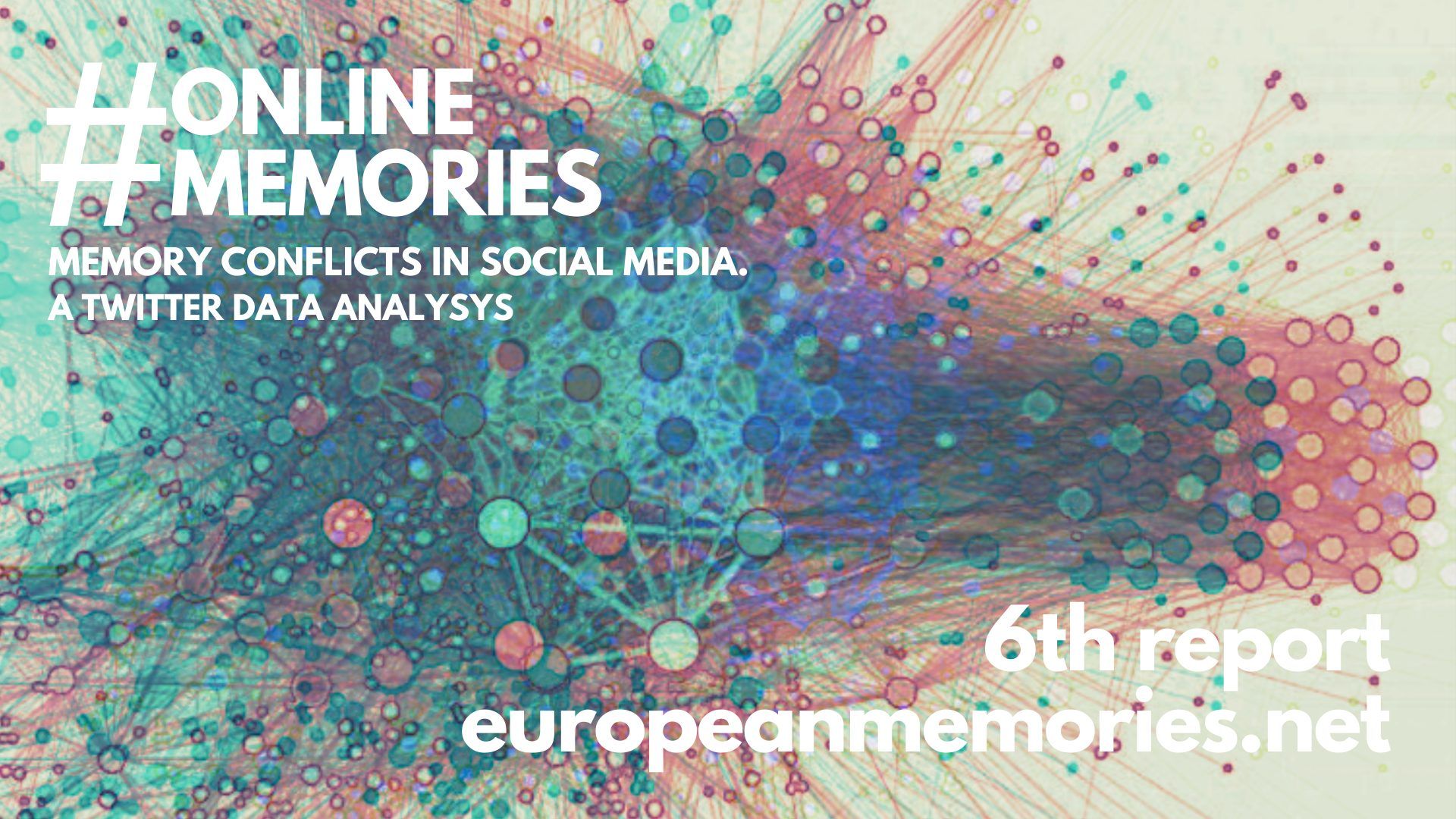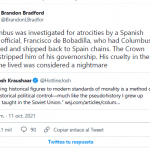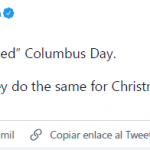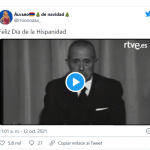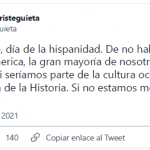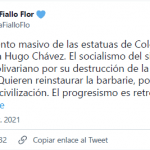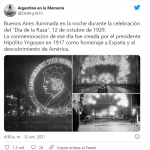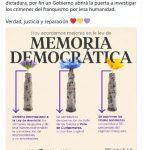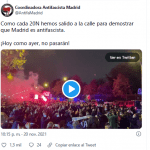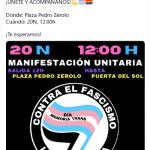Memory conflicts on social media: Twitter data analysis
Sixth report – Second semester, 2022
Texts by Celeste Muñoz Martínez | Graphs by Mariluz Congosto
Sociological profile and theoretical stance
The Online Memories project, now concluding its third year, is organised on an annual basis by way of two six-monthly reports. In the first report, which corresponds to the first semester, all the sociological data (use of networks and profiles) from the previous year are updated. Theoretical considerations as well as methodological issues are included. Thus, the two reports of the period comprise a single report, which we decided to divide into two parts on account of the data’s volume and magnitude. Therefore, to broach any of these issues, please see the first report of 2021.
Commemorations included in this report
Three commemorations have been analysed in this report, namely, (1) the Day of Remembrance for the Victims of Totalitarian Regimes (23 August), (2) Hispanic Day (12 October) and 3) the anniversary of the death of Francisco Franco (20 November).
| Commemoration | 2019 | 2020 | 2021 |
| Day of Remembrance for the Victims of Totalitarian Regimes (23A) | X | X | X |
| Hispanic Day | X | X | |
| Anniversary of the death of Francisco Franco | X |
Table 1. Summary of regularity in the analysis of each commemoration
Case studies
Day of Remembrance for the Victims of Totalitarian Regimes (Black Ribbon Day)
August 23 marks the “European Day of Remembrance for the Victims of Totalitarian Regimes”, popularly known as Black Ribbon Day. It aims to acknowledge and honour the victims of Nazism and Communism. This commemoration is not confined to the European Union as it is also recognised and celebrated in the USA and Canada. Although the proposal arose at the end of the Cold War, in the wake of a number of protests such as the Baltic Way, its celebration in Europe was not formalised until 2009 (533 votes in favour, 44 against and 33 abstentions).[1] The date of its celebration, 23 August, marked the anniversary of the Molotov-Ribbentrop Pact in 1939. In 2020, 23 August was used by the Belarusian opposition to instigate a series of protests and a mass demonstration, being one of the largest signs of support for the celebration to date.[2] In addition, this commemoration channels part of the tensions between the EU and Russia today, with the condemnation of Stalinism and its comparison with Nazism being a bone of contention. The initiative behind this commemoration was spearheaded by a number of Eastern European countries (especially Poland), which have executed initiatives to consider the glorification of Communism and the denial of its crimes as “hate crimes”. In Spain, VOX has put forward several proposals for it to be recognised as a national and local holiday.
Data File
| Collection method | Streaming APIs / search APIs |
| Collection period | 21 to 28 August 2021 |
| Words searched |
Víctimas regímenes totalitarios |
| Number of original tweets obtained | 3,993 |
| Number of tweets + RTs | 33,188 |
Evolution of participation
Twitter data for the Day of Remembrance for the Victims of Totalitarian Regimes were collected in 2020 and 2021 with streaming APIs whereas web scraping was used in 2019. Therefore, the number of tweets in 2019 is not comparable to the years 2020 and 2021. The number of original tweets grew from 2020 to 2021, but the number of unique users and the percentage of RTs dropped. Nevertheless, no significant changes in trends are observed and we can assert that, of all the commemorations analysed, it is the one bearing the least impact on social media.
| Year | Original Tweets | Tweets + RTs | % of RT | Unique users |
| 2019 | 4,527 | 23,054 | 80.36% | 11,647 |
| 2020 | 3,993 | 33,188 | 87.96% | 22,985 |
| 2021 | 4,717 | 31,369 | 84.96% | 21,352 |
Table 2. Evolution of participation
The following table shows the words selected for each of the years. In 2021, it was extended to other languages (Russian and Catalan), and is thus the most representative example.
| 2019 | 2020 | 2021 |
| Víctimas regímenes totalitarios Víctimas del Estalinismo Nazismo Victims totalitarian regimes Victims of Stalinism and Nazism Victimes des régimes totalitaires Victimes du nazisme stalinisme Totalitäre Regime der Opfer Opfer des Nationalsozialismus Stalinismus Regimi totalitari delle vittime Vittime del nazismo Stalinismo Ofiary totalitarnych reżimów (Polish) тоталитарних режима (Serbian) Totalitárius rendszerek áldozatai (Hungarian) Žrtve totalitarnih režima (Bosnian) Žrtve totalitarnih režimov (XSlovenian) Totalitné režimy obetí (Czech-Slovak) Ohvrid totalitaarsed režiimid (Estonian) Жертви тоталитарни режими (Bulgarian) Regimuri totalitare ale victimelor (Romanian) Upuri totalitārie režīmi (Latvian) Nukentėjo totalitariniai režimai (Lithuanian) #BlackRibbonDay #80WW2 #BlackRibbonDay2019 #BalticWay30 #pamietamy #MolotovRibbentroppact #PowstanieWarszawskie #RememberAugust23 |
Víctimas regímenes totalitarios Víctimas del Estalinismo Nazismo Victims totalitarian regimes Victims of Stalinism and Nazism Victimes des régimes totalitaires Victimes du nazisme stalinisme Totalitäre Regime der Opfer Opfer des Nationalsozialismus Stalinismus Regimi totalitari delle vittime Vittime del nazismo Stalinismo Ofiary totalitarnych reżimów (Polish) тоталитарних режима (Serbian) Totalitárius rendszerek áldozatai (Hungarian) Žrtve totalitarnih režima (Bosnian) Žrtve totalitarnih režimov (Slovenian) Totalitné režimy obetí (Czech-Slovak) Ohvrid totalitaarsed režiimid (Estonian) Жертви тоталитарни режими (Bulgarian) Regimuri totalitare ale victimelor (Romanian) Upuri totalitārie režīmi (Latvian) Nukentėjo totalitariniai režimai (Lithuanian) #BlackRibbonDay #BlackRibbonDay2020 #BalticWay #pamietamy #MolotovRibbentroppact #PowstanieWarszawskie #RememberAugust23 |
Víctimas regímenes totalitarios Víctimas del Estalinismo Nazismo Victims totalitarian regimes Victims of Stalinism and Nazism Victimes des régimes totalitaires Victimes du nazisme stalinisme Totalitäre Regime der Opfer Opfer des Nationalsozialismus Stalinismus Regimi totalitari delle vittime Vittime del nazismo Stalinismo Ofiary totalitarnych reżimów (Polish) тоталитарних режима (Serbian) Totalitárius rendszerek áldozatai (Hungarian) Žrtve totalitarnih režima (Bosnian) Žrtve totalitarnih režimov (Slovenian) Totalitné režimy obetí (Czech-Slovak) Ohvrid totalitaarsed režiimid (Estonian) Жертви тоталитарни режими (Bulgarian) Regimuri totalitare ale victimelor (Romanian) Upuri totalitārie režīmi (Latvian) Nukentėjo totalitariniai režimai (Lithuanian) #BlackRibbonDay #BlackRibbonDay2020 #BalticWay #pamietamy #MolotovRibbentroppact #PowstanieWarszawskie #RememberAugust23 Жертвы тоталитарных режимов (Russian) Жертвы сталинизма нацизма (Russian) Балтийский Путь (Russian) Пакт Молотова-Риббентропа (Russian) Víctimes règims totalitaris (Catalan) Víctimes nazisme estalinisme (Catalan) |
Analysis of the graphs
Generally, as we saw in previous reports, the criteria employed to identify communities and define the graphs are based on language, geography, and ideology. Our analyses are based on the intersections between these criteria and on the links between communities (affinity-distance).
By way of the analysis of the graphs, dissemination is found to be highly dispersed, with almost 30.13% of the profiles belonging to isolated groups or containing less than 3% of the participants. Within the graph examined, communities are also highly fragmented, the largest being a group of neoliberal profiles in Spain with 16.38% of the profiles and another in Canada critical of their government with 8.37%. The other groups account for less than 6% of users (graph 1). In addition, a huge distance is noted between communities, with little interaction between them. In this respect, the graph shows four poorly connected areas, demarcated sometimes by language and at other times by ideology. The graph’s central zone corresponds to a block of English-speaking communities supporting the celebration of the Day of Remembrance for the Victims of Totalitarian Regimes, with profiles from the EU, Greece, Lithuania, Poland, Slovenia, and other Eastern countries. This year the EU’s prominence was lower than the previous year on account of the lesser impact of the messages posted by European institutions and leaders. In this regard, no real will to support the commemoration is noted. The bottom right features a group critical of the European Parliament’s message in Spanish (@Europarl_ES). It is made up of profiles from Spain, mostly exhibiting neoliberal ideology. The group’s most popular messages were deleted. The top part features Canadian profiles, some for and some against the government. Justin Trudeau was the author of a much-quoted tweet with negative comments. In the bottom left, grouped together are profiles posted in English and Spanish who deny the existence of victims of Stalinism and support Communism.
Compared to the previous year, three changes are noted. The first is the lesser impact of the messages transmitted by European institutions, the second is the rise in denialism of victims of Stalinism. The third is the near-disappearance of profiles from Hong Kong calling for their “Baltic Way”.

Graph 1. Tweet dissemination by affinity community in 2021

Graph 2. Tweet dissemination by affinity community in 2020
In terms of language distribution (Graph 3), English predominated (53.77%), being used by Lithuanians, Slovenians, Poles, Canadians and other EU profiles. The second most widely disseminated language was Spanish (27.42%) employed by users from Spain and Latin American countries. The third language was Greek (4.62%), the fourth was French (3.21%) and the fifth was Polish (2.66%). The presence of Eastern European languages, albeit small percentage-wise, is significant. Attention is drawn to this point given its uncommon occurrence in other European commemorations, which also points to a higher degree of support in countries in the former Soviet bloc.

Graph 3. Graph of RTs by language
Most tweets did not include a hashtag (Fig. 4). The most frequent hashtag was #BlackRibbondDay, present in 5.77% of the tweets. The second was #blackribbonday (lowercase option used by the Greeks). The third #BalticWay had a presence of 3.15%.

Graph 4. Graph of RTs by hashtag
Temporal dissemination
An alternative view of dissemination represented by graphs is the time evolution of the original tweets’ publication. This study considered original messages to be those that imply that the author created his or her own message either by posting a text, by replying to another user’s tweet or by quoting a tweet to which a comment was added (this option is also called retweet with comment.) In all three cases it implies that the author typed a text that involved greater effort than pressing a key to circulate it. On Twitter, there is a great deal of amplification, with the percentage of retweeted messages being over 80% for most of the topics analysed. In this case, the percentage of original messages (tweets, quotes and replies) is 15.44%, so the percentage of amplification is 84.96%. Let us remind you that our standpoint on this matter is that the agents generating memory are those who create the content; and that the social acceptance of this memory can be assessed by the level of amplification via RT – always taking into account the sociological profiles presented, the Twitter bubble, the gender factor and affiliation to communities. Memories identified on the Internet, like all memories, must always be situated within their real context and reach.
The following graphs analyse the time evolution of the publication of messages, both original messages and retweets. As is customary, intensity was lower on the days prior and subsequent to the celebration. Most tweets were concentrated between 23 and 24 August. Fig. 1 shows the ratio between tweets published and RTs received in one-hour intervals. It is a two-scale graph, tweets from 0 to 224 (from 0 to 233 in 2020) and retweets from 0 to 1,119 (0 to 3,133 in 2020).

Fig. 1. Tweets vs. Retweets
The participation of different groups is shown in Fig. 2 in which European and American working hours are mixed, making the latest publication time 15:00 (GMT time) when activity in Europe and North America’s East Coast coincides.

Fig. 2. Tweets by group
The content
Once the general trends of this commemoration are presented, the most pertinent content needs to be situated. Firstly, in the top ten messages, the poor institutional relevance is noteworthy. These messages did not include any official institution capable of generating widely disseminated content. However, a tweet by the European Parliament is widely quoted by profiles critical of its content. These criticisms do make an appearance in the top ten messages of the day. In fact, the most widespread tweet was published by the former politician of the liberal party Ciudadanos Juan Carlos Girauta (@GirautaOficial), which corrected the tweet of the European Parliament in Spain (quoted below) with the following message: “Del comunismo y el nazismo, querrán decir” [From Communism and Nazism, they mean]. A criticism widely replicated by profiles all over Spain that aim not only to condemn Stalinism, but Communism as an ideology. For instance, the profile @crpandemonium similarly wrote “No se dice estalinismo, se dice comunismo. A blanquear ideologías genocidas a otro lado” [We don’t say Stalinism, we say Communism. Go launder genocidal ideologies elsewhere] (seventh most widespread message). Both the tweet by @crpandemonium and the tweet by Juan Carlos Girauta were deleted. We also draw attention to a message along the same lines by the far-right journalist, former spokesperson of the group HazteOir, Javier Villamor. All messages with similar content are found in the Spanish neoliberal community.
Photo 1. Tweet criticised by numerous profiles for its exclusive mention of Stalinism
Another widely circulated message was one by journalist Ben Norton quoting the message of the Prime Minister of Canada, Justin Trudeau, through which he supported the commemoration of 23 August. Ben Norton, like many others, quoted the tweet to criticise the president for his equating Nazism with Communism. Others availed of the opportunity to criticise the president for his “authoritarian” measures, such as the establishment of the Covid Passport. An assortment of ideologically heterogeneous criticisms, with very different messages.
Furthermore, the criticism of Trudeau made up a strong specific community of people who deny the victims of Communism and who reject the commemoration. This community criticised numerous messages during the day that supported the commemoration of 23 August, not only that of the Prime Minister.
Among this community against the celebration, noteworthy is the group of Spanish communists, especially active during the day. Interestingly, the tweet posted by the European Parliament in Spain was at the forefront of their criticism.
The tweets supporting the commemoration also included topical political messages. An example is the condemnation of the Taliban regime in Afghanistan, following the withdrawal of NATO troops also during the month of August 2021. References to the Baltic Way were also frequent in the content supporting the commemoration, especially among the Lithuanian community and Eastern Europe.
Hispanic Day
Hispanic Day, celebrated every 12 October, refers to the anniversary of the “discovery” of America by Christopher Columbus in 1492. A commemoration celebrated both in Spain and throughout the American continent, but which has taken on different meanings throughout history. In the USA, it assumes the name of Columbus Day, for example. In Spain, in the 20th century it was renamed Hispanic Day, Columbus Day or National Day (or of the armed forces); in Latin America it has been contested and replaced in some countries by Indigenous Resistance Day, among others. This elasticity of uses and transformations is a response to the conflicting interpretations of colonialism and the rise of decolonial movements in recent decades. For instance, in the #BlackLivesMatter protests, various statues of conquerors and colonisers were destroyed, since the symbols of this past have given impetus to racial tensions in the present. For this reason, the monitoring of this commemoration makes us aware of one of the greatest memory conflicts today.
Data file
| Collection method | Twitter streaming APIs (collected in real time) |
| Collection period | 7 to 15 October 2021 |
| Words searched | #12Octubre #12deOctubre #12Oct #Hispanidad Hispanidad Día de la resistencia indígena #DíaDeLaResistenciaIndígena #DiadelaRaza Día de la raza #NadaQueCelebrar #ResACelebrar Res A Celebrar #Ezerezospatzeko ezer ez ospatzeko #ColumbusDay Columbus Day #BlackLivesMatter |
| Number of original tweets obtained | 305,225 |
| Number of tweets + RTs | 1,252,691 |
Evolution of participation
The evolution of activity on Twitter on Hispanic Day reached its peak in 2021. The reason may be attributed to the inclusion of keywords used in the USA, including the hashtags #ColumbusDay and #BlackLivesMatter. However, in recent years, there has been a much stronger movement opposed to this celebration, which intensifies the debate. The percentage of RTs compared to original tweets was lower than in 2020 and similar to 2019.
The number of unique users who participated rose considerably from 2019 to 2021, but it must be borne in mind that:
- In 2019, data were collected via web scraping and therefore less tweets were collected.
- In 2020, due to a data capture error, tweets with the hashtag #12Oct and the word “Hispanidad” were not collected (both words were separated with a full stop rather than a comma). Those tweets could not be retrieved with the API because the error was detected too late and because the web scraping method had stopped working on Twitter. In 2020, it must also be taken into account that national holiday parades were not held on account of COVID-19.
- In 2021, US profiles were included.
| Year | Original tweets | Tweets + RTs | % de RTs | Unique users |
| 2019 | 33,740 | 134,462 | 74.90% | 61,491 |
| 2020 | 105,952 | 594,954 | 82.19% | 262,378 |
| 2021 | 305,225 | 1,252,691 | 75.63% | 457,520 |
Table 1: Evolution of participation
The following table shows the words selected for each of the years. In 2021, it was extended to other languages (English, Catalan and Basque).
| 2019 | 2020 | 2021 |
| #12Octubre #12deOctubre #12Oct Hispanidad #Hispanidad Día de la resistencia indígena #DiaDeLaResistenciaIndigena #DiadelaRaza día de la raza |
#12Octubre #12deOctubre #Hispanidad Día de la resistencia indígena #DíaDeLaResistenciaIndígena #DiadelaRaza Día de la raza |
#12Octubre #12deOctubre #12Oct #Hispanidad Hispanidad Día de la resistencia indígena #DíaDeLaResistenciaIndígena #DiadelaRaza Día de la raza #NadaQueCelebrar #ResACelebrar Res A Celebrar #Ezerezospatzeko ezer ez ospatzeko #ColumbusDay Columbus Day #BlackLivesMatter |
Table 2. Words monitored
Analysis of the graphs
The dissemination structure clearly shows two blocks, separated by language: English (upper right) and Spanish speaking (middle and bottom left). In turn, these blocks are divided into groups by ideology and geography (Graph 1).

Graph 1. Tweet dissemination by community
Dissemination was less dispersed than in 2020, since the 12 largest groups account for 81.22% of profiles. There is a division of opinions over the celebration of Hispanic Day that is illustrated in the graph as follows:
- The English-speaking zone includes three groups opposed to the celebration of the discovery: “Indigenous Peoples’ Day-1” (13.45%), “Indigenous Peoples’ Day-2” (8.54%) and “BlackLivesMatter” (2.95%). The support group is “Columbus Day” (10.82%). The contrary opinion overwhelmingly prevails.
- In the Spanish-speaking block, there is a contrary opinion in the groups “Izquierda e Independentismo” [Left and Independence Movement] (8.78%), “México” [Mexico] (4.46%) and “Venezuela-Rebeldíaindigena” [Venezuela-Indigenous Rebellion] (4.07%). The support groups are “Derecha Española” [Spanish Right] (10.4%), “Derecha Venezolana” [Venezuelan Right] (4.2%), “Derecha Española e Instituciones” [Spanish Right and Institutions] (3.35%) and “Argentina” (3.05%). The group “Tweeters españoles” [Spanish Tweeters] (7.15%) is ironic and varied in memes, although it is more connected to opposing groups. The bottom line is 17.31% against versus 21% in favour (not including the ironic group).
Thus it is clear that we are dealing with a commemoration that gives impetus to a high degree of fragmentation both at the social and political levels in almost all the countries in which it is celebrated. This trend was already observed in the graph of the previous year (graph 2), although it is much more marked in 2021 and we must take the aforementioned determining factors into account.

Graph 2. Communities in 2020
In 2021, multimedia and powerful explicit images were used, as we shall see in the content analysis of each community. A rise in the trend to use quotes to criticise a message is also noted.
In terms of language distribution (Graph 3), Spanish predominated, as a result of being the most common language of the countries that took part in the commemoration (51.59%). The second language used was English (40.47%), followed by Catalan in third place (2.8%). A comparison cannot be made with the year 2020 because keywords in English and Basque were not included. However, Catalan accounts for 2.8%, an absolute and relative percentage higher than in 2020. Tweets in Catalan tend to correspond to nationalist communities, generally opposing the celebration of 12 October, because it is in fact Spain’s national day.

Graph 3. Graph of RTs by language
Most tweets did not include a hashtag (Graph 4). The most frequent tag was #12Octubre present in 4.15% of the tweets. The second was #12deOctubre with a presence of 3.86%. The third was #12Oct (3.69%) and the fourth #ColumbusDay (3%). The use of tags was based on geography in some cases, such as #12Oct that was used in two groups in Venezuela. In other ideology-based cases, #NadaQueCelebrar and #ResACelebrar [Nothing to Celebrate were used by the left and pro-independence movements. The Spanish right used #12Octubre and #Hispanidad, and Ibero-American countries opposed to the celebration used #12DeOctubre and #12deOctubre. Compared to the previous year, the higher presence of the tag #12Oct is noted, which was inadvertently not collected in 2020. It should be noted that, due to format limitations when putting this graph together, only one tag can be included. In this case, the first hashtag that appears in the tweet was selected as it is considered to be the most important one. There may be secondary tags that were also frequent but will not appear below for this reason.

Graph 4. Graph of RTs by hashtag
Temporal dissemination
As usual, intensity was lower on the days prior and subsequent to the day of celebration. Most tweets were concentrated between 11 and 12 October. Graph 1 shows the ratio between the number of tweets posted and RTs received in one-hour intervals. It is a two-scale graph, tweets from 0 to 12,792 (from 0 to 7,338 in 2020) and retweets from 0 to 36,805 (from 0 to 56,876 in 2020). In 2021, the percentage of RTs was lower than in 2020.

Fig. 1. Tweets vs. Retweets
The participation of relevant profiles is shown in graph 2, which records profiles with more than four million followers who participated. Most of them were media and institutions.

Fig. 2. Tweets vs. Reach
The participation of different groups is shown in Figure 3 in which European and US working hours are combined, making the latest posting time 14:00 (GMT time) when activity in Europe and the US coincides. The groups Indigenous Peoples’ Day-1, Indigenous Peoples’ Day-2 and Columbus Day, all with a majority of profiles from the USA, were very active on the eve of 12 October.

Fig. 3 Tweets by Group
Hashtag presence in the tweets (4) was concentrated on 12 October, the most frequent tag being #12Octubre, followed by #12deOctubre and #12Oct.

Fig. 4. Hashtag presence in tweets
Content analysis
Given the number of communities interacting with this commemoration, a segregated analysis thereof has been performed, although many of them share a stance regarding the date.
On the one hand is the community that decided to celebrate Indigenous Peoples’ Day, clearly opposed to the positive commemoration of colonisation or the defence of its symbols. This community is made up of non-institutional or non-political profiles that generally post in English and are noteworthy socially speaking for the broad participation of Afro-Americans.
Given the number of communities interacting with this commemoration, a segregated analysis thereof has been performed, although many of them share a stance regarding the date.
On the one hand is the community that decided to celebrate Indigenous Peoples’ Day, clearly opposed to the positive commemoration of colonisation or the defence of its symbols. This community is made up of non-institutional or non-political profiles that generally post in English and are noteworthy socially speaking for the broad participation of Afro-Americans.
Numerous messages were also issued by the Spanish right in defence of the conquest and colonisation of America by Christopher Columbus and the Spanish empire. The leader of the far-right party (VOX), Santiago Abascal, posted a message that was among the most widely disseminated ones throughout the day. Messages supporting the Spanish Civil Guard and the armed forces are also notable in this community.
Among Spanish left-wing and pro-Catalan independence groups, the tag in Catalan #ResACelebrar [Nothing to Celebrate] is notable. The most widespread tweet was by the former president of the Government of Catalonia in exile in Belgium, Carles Puigdemont. These messages, posted by profiles with very different ideological leanings, coincide in condemning colonialisation and question whether such a feat is a reason for a national holiday in Spain. The left condemns the far-right demonstrations celebrated throughout the day.
On another note, although closely related, is the meme community. They generally posted parodies during the day, opposed to the celebration and with particular prominence of the supposed tricolour flag that was drawn in the sky during the military parade.
Also noteworthy are opposed communities in various Latin American countries (Mexico and Venezuela, mainly). The rejection of Hispanic culture is mixed with topical political issues in their respective communities.
Notable among the supporters of the commemoration in Latin America are the Venezuelan and Argentine right (calling the commemoration Día de la Hispanidad or Día de la Raza, interchangeably). The communities availed of the opportunity to also condemn left-wing political parties in their respective countries.
Finally, it should be noted that tweets were also posted under the hashtag of BlackLivesMatter by both an English- and Spanish-speaking community. Despite originating in the USA, following the murder of George Floyd, the hashtag spread throughout the world and is a symbol of the fight against racism and the vestiges of colonialism. It was also used on this date, albeit to a lesser extent and sometimes bearing no relation to the commemoration, to condemn other incidents of racism.
20N, anniversary of the death of Francisco Franco
In 2021, we decided to sample one of the Spanish State’s unofficial social commemorations for the first time. As on previous occasions (especially on 14 April), note that these types of posts separate from institutional action and organisation correspond to a type of memory on the margins. Therefore, to explore their content is to delve into the evolution of social constructs associated with patently uncomfortable festivities. November 20 is the anniversary of the Spanish dictator Francisco Franco – and leader of the Falange’s founder, José Antonio Primo de Rivera. Franco’s death marked the end of almost 40 years of dictatorship and the beginning of the process of transition to democracy. However, publicly this date is an uncomfortable memory at institutional level. To avoid addressing the implications of the death of Franco or of his figure, at political level this event has been buried in oblivion. Nevertheless, on a social level, it continues to be remembered. For some, nostalgic for Francoism, it is remembered in mourning, while for others, opposed to the dictatorship, it is the celebration of the death of a murderer.
Data file
| Collection method | Streaming APIs |
| Collection period | 14 to 26 November 2021 |
| Words searched | #20N 20N Aniversario muerte de franco Aniversario muerte del dictador Franco murió en la cama Valle de los caídos Primo de Rivera Transición española Dictadura franquista Franquismo muerte de Franco #Francoland Franquisme |
| Number of original tweets obtained | 45,437 |
| Number of tweets + RTs | 246,784 |
Evolution of participation
The Twitter data concerning the anniversary of Franco’s death were collected for the first time in 2021. There is therefore no comparison with previous years. The data were downloaded with streaming APIs.
Analysis of the graphs
On 20N, in addition to the celebration of the anniversary of Franco’s death, other events coincided, such as a demonstration in Cuba on 20 November and the Transgender Day of Remembrance celebrated on this date. The data related to Cuba were removed for the analysis, but the data corresponding to the Transgender Day of Remembrance have been maintained because this group also mentioned Franco through interactions.
Each one of the graph’s nodes corresponds to a Twitter profile that either posted a tweet or retweeted it. One node is connected with another when it is retweeted. In most cases, RTs are an upvote for a tweet. When a modularity algorithm is applied, the profiles that have the most common retweets are grouped into communities and reveal the structure of the network of connections. The shape of the graph corresponds to an algorithm of forces in which the most connected nodes attract each other and the least connected nodes repel each other. Therefore, through them we represent communities that attract and repel each other, which interact and connect in the network.
Graph 1 shows a two-block structure, associated with a polarisation in which the tweets circulate through two echo chambers. On the left-hand side, profiles related to the left are grouped together (28.92%, shades of purple), with pro-Catalan independence (10.92%, yellow) and with left-wing sympathiser tweeters (12.8%, shades of blue) and with anti-fascist and transgender groups (3.78%, brown) On the right-hand side are profiles related to the right (22.03%, mustard) and with the Falange and denialism (3.27%, dark green). In this regard, we see that the pandemic, Catalan independence or the rights of transgender people enter the debate surrounding this commemoration, as they are topics of recurring political debate on the left-right axes.

Graph 1. Tweet dissemination by community
In terms of language distribution (graph 2), Spanish predominated (84.91%, red), followed by Catalan (8.82%, yellow). Catalan dominated the tweets of the pro Catalan independence group, although there were crossed RTs in both languages with the left-wing group (yellow and red zone).

Graph 2. Graph of RTs by language
The existence of HTs was minor, only 8.03% of users employed the hashtag #20N. Most tweets did not include a hashtag (Graph 3). The few HTs identified were found in the groups Tuiteros, Falange – Antivacunas and Antifascismo – Trans. In this regard, note that in our theoretical framework HT is analysed as a phenomenon that holds digital memory, because it is easily traceable in time and unites communities in its content. However, as we have been warning, much of the content is posted with no HT. This implies that, if we treat Twitter as a file, the bulk of content is easy to lose over time, since it is not recorded in a tag. However, it is evident that memory phenomena are mostly devoid of HT and work should methodologically be carried out on how to better preserve and trace the content without tags – otherwise we run the risk, in retroactive analysis, of basing assertions on overly biased analyses.

Graph 3. Graph of RTs by hashtag
Temporal dissemination
The following graphs analyse the time evolution of the publication of messages, both original messages and retweets. In previous reports the graphs were compiled only around original tweets due to limitations of the viewing tool. In the 2021 reports, the tool was changed and the graphs were compiled around the total number of tweets.
Close to the date of 20N, two events occurred. The first was on 17 November with the debate surrounding the repeal of the amnesty law – to allow Franco-era crimes to be investigated –; and the second on 21 November, when the attendance of Pablo Casado, leader of the Partido Popular, at a mass for Francisco Franco came to light. Both events bore a major impact on Twitter, so the timeline in this case is atypical if compared with previous commemorations, since three high points appear instead of a single moment on the day of the celebration.
In this case, on 17 November, there was a sharp increase as a result of the repeal of the amnesty law, which gradually subsided until 20 November, when it began to rise again and reached its peak. The news of Pablo Casado’s attendance kept the level of posting high for three additional days. Fig. 1 show the ratio between tweets posted and RTs received in one-hour intervals. It is a two-scale graph, tweets from 0 to 674 and retweets from 0 to 2,831. The ratio of RTs to original tweets was maintained until 17 November.

Fig. 1 Tweets vs. Retweets
The participation of relevant profiles is shown in Fig. 2 in which the profiles with more than one million followers who participated are noted. Most of them were the media, journalists, political parties and leaders, which is interesting if it is borne in mind that the celebration has no official value. The double-scale graph shows the ratio between the number of tweets posted in one hour, original messages or RTs, and the possible reach. The reach is calculated as the sum of followers of those who posted in each hour. It is noted that the ratio between reach and the original tweets posted is lower subsequent to 20N.

Fig. 2. Tweets vs. Reach
The participation of various groups is shown in Fig. 3, where it is noted that groups related to politics, both right- and left-wing, posted more the day of the repeal of the amnesty law (17th) than on the anniversary of Franco’s death. The pro-Catalan independence movement group was more active on 20N and unaffiliated tweeters posted when Pablo Casado’s attendance at the mass for Franco came to light.

Fig. 3. Tweets by Group
Hashtag presence in tweets (Fig. 4) was concentrated on 20 November, the most frequent tag being #20N.

Fig. 4. Hashtag Presence in tweets
In analysing the breakdown by language (Fig. 5), the predominance of Spanish, followed by Catalan, can be seen. The day with the highest number of tweets posted in Catalan was 20N.

Fig. 5. Breakdown of tweets by language
Content analysis
The content analysis continues to interpret the findings broken down by community. To this end, the most widely disseminated tweets within each group were included, which paint a picture of the hegemonic discourses, although admittedly not the only discourses.
In the right-wing community, the most widely disseminated tweet was that posted by the liberal economist Jano García, with a tweet critical of the PSOE-Podemos coalition government. In fact, most of this community’s tweets over this day were along these lines: criticising the coalition by appealing to alleged use of memory policies related to Francoism to cover up other issues, which in their opinion are more pertinent. It is here where critics of the pandemic’s management connected with the rights of the right and far-right.
The anti-vax community, though it connects and interacts with affinity with the right-wing axis, had its own story. Messages against the supposed “health dictatorship” – in reference to the anti-Covid measures, were the most common. Members of the Falange (Spanish far right) are found in this community, due to proximity in their interactions, although they did not refer to the anti-Covid measures. Four of the ten most widely disseminated tweets by this community were removed for violating Twitter’s rules.[3]
Unlike the right wing’s community, the left-wing block had a more political role. The main tweets were by the Vice-President of the Government, Yolanda Díaz (Podemos); the organisation secretary for Podemos, Pablo Echenique; Juan Carlos Monedero, also from Podemos; and the journalist Ignacio Escolar. The majority celebrated the recent committee approved to investigate Franco-era crimes that the right criticised. Also noteworthy is the criticism of the leader of the Partido Popular, Pablo Casado, for his attendance at a mass in memory of the dictator.
In the community sympathising with the Catalan independence movement, there was no common consistency of content. There were some tweets defending the Catalan language or some criticism of Pablo Casado’s attendance of the mass. The only notable element is a poem by Joan Brossa dedicated to the death of the dictator that was made viral by various people, including writer Marius Serra and the former CUP [Popular Unity Candidacy] member of the Catalan Parliament, David Fernàndez.
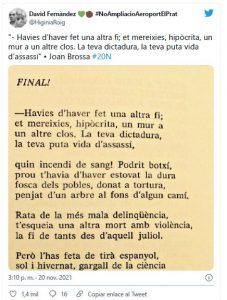
As far as the anti-fascist and transgender community is concerned, worth noting is the dissemination of the anti-fascist demonstration in Madrid and messages advocating for the rights of the trans community, who also took part in the convening. These communities also lie along the left-wing axis.
Finally, the Internet also had space for the usual memes. This time they very much centred on Pablo Casado’s controversial attendance at the mass for Francisco Franco. This community, again, lies along the left-wing axis.

The commemoration of 20 November sees a highly polarised network, as the graph itself alerted. There are few connections between the left-right axis, with opposing discourses and with no intermediate communities in the story. Left-wing communities concurred on the need to investigate Franco-era crimes, to amend the amnesty law, to criticise the certain continued existence of Francoism in today’s far right or to remember that the dictator died in bed, without serving justice. For its part, the right criticised any memory initiative calling for a hierarchy of priorities, demanding that more urgent political initiatives be put first. However, it is worth mentioning that there were no discourses associated with heightened nostalgia for Francoism or glorification, or at the very least, that they were not the most viral. Also noted is the absence of the right’s political front row, VOX and PP, in these communities’ messages. The content was posted by users with no political profile. Conversely, on the left-wing axis, the opposite occurred.
Notes
[1] See: https://ec.europa.eu/commission/presscorner/detail/en/STATEMENT_21_4283
[2] See: https://crisis24.garda.com/alerts/2020/08/belarus-thousands-defy-army-warning-and-protest-in-minsk-august-23-update-25
[3] In the first report of 2021, an analysis was carried out of Twitter’s censorship policies related to hate and fake news.

